Reviewing D&D Monsters - 5E Monster Manual, Fomorians to Gnolls
Written on: 10月 23, 2019
Reviewing D&D Monsters - 5E Monster Manual, Fomorians to Gnolls - Hi friends, I hope you are all in good healthkanakoroku, In the article you are reading this time with the title Reviewing D&D Monsters - 5E Monster Manual, Fomorians to Gnolls, We have prepared this article well for you to read and take information in it. hopefully the contents of the post
Artikel Dungeons & Dragons,
Artikel Game,
Artikel Reviewing Monsters, what we write you can understand. ok, happy reading.
Title : Reviewing D&D Monsters - 5E Monster Manual, Fomorians to Gnolls
link : Reviewing D&D Monsters - 5E Monster Manual, Fomorians to Gnolls
And, hey, we're basically almost halfway through the Monster Manual. Woop woop!
Click here for the previous part, covering Dryads to Flumphs.
Click here for the next part, covering Goblins to Kenku.
Click here for the index.
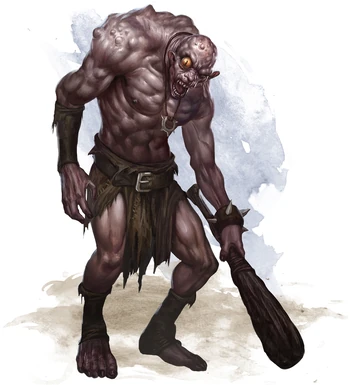

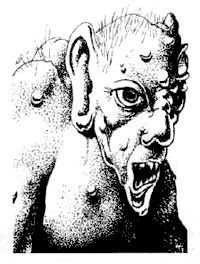
Fomorian
The Underdark basically has a lot of evil, twisted versions of the creatures from the surface world. The Duergar and Derro are are dishonourable and evil slavers, in contrast to dwarves. The Drow are a bunch of cutthroat assassin-cultists, in contrast to elves. TheSniffle- Srivflbel- Sniffleblin-the deep gnomes are a bunch of suspicious, paranoid xenophobes in contrast to gnomes. And one of the races that got an Underdark counterpart are the giants... sort of. The Fomorians are known as the most hideous and the most wicked of the giants, and are portrayed as being deformed, malformed twisted mockeries of normal, regular giants. That's the whole thing that differentiates them visually. They're so malformed that their eyes are of different sizes, their arms are mismatched and the 5th Edition even notes that "some have facial features randomly distributed around their misshapen, warty heads". And... yeah, that's about it. They're ugly, they're evil, and they're giants. Some of the stronger ones are able to use their "Evil Eye" to curse others to be deformed.
They do have a neat backstory, though, where they used to be a tribe that attempted to wrest control of the Feywild's magics for themselves, but as anyone knows, fucking with faeries is probably as dangerous as fucking with demons, and the proto-Fomorian giants were all twisted and warped by the faeries' curse, being driven off into the Underdark. They're one of the monsters that keep showing up in every edition, but considering that D&D has no shortage of other giant-kin, the Fomorians always felt just kinda there to me, just malformed, particularly brutal slavers and brutish monsters that live underground. It's a neat, classic monster, don't get me wrong, but I've never really been impressed by it.
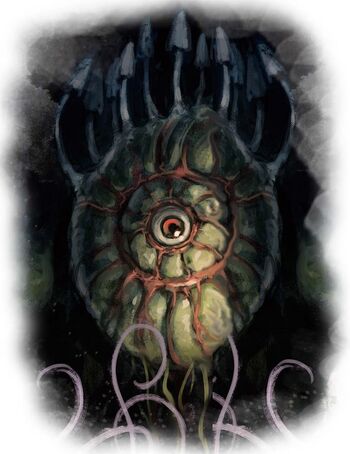
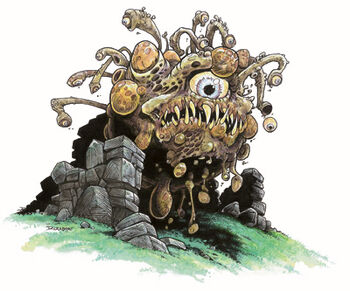
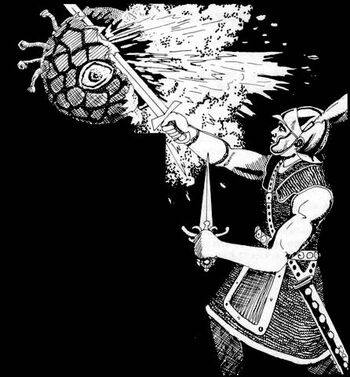
Fungus: Gas Spore
Fungi! While the D&D system basically lumps together the fungi as "Plant" type creatures, it's more for the sake of convenience more than anything, the same way that every single not-technically-a-dragon creature is slapped the "draconic" type. And the fungi has been around, bothering players, ever since the inception of the game. The setting and locale that the dungeons tended to be set in -- dark, damp and abandoned -- is just prime material for fungi to grow, so yeah, we've got a whole lot of fungus creatures. The Monster Manual showcases three particular examples in their "Fungus" category, and we're going to go through these three classic D&D fungi!
The original Monster Manual had a whole load of interesting "just to fuck with your players" obstacles, and the Gas Spore was noted to look exactly like a Beholder, but when a foolish adventurer strikes the "Beholder", it turns out that it's just a floating fungal puffball balloon mimicking a Beholder. Oops, now you have a face full of toxic fungal spores! And without treatment, your character will fucking die within days. All because you mistook a fucking mushroom balloon for a Beholder. Of course, while a fun (if assholish) little gimmick for a game obstacle, you really have to wonder just what the fuck ended up with these fungi evolving to mimic one of the most dangerous aberrations in existence. And the Gas Spores have sort of waffled back and forth from being just a generic footnote in the Beholder section, to that absolutely grody mass of mushrooms and mycellium mimicking a decaying Beholder in 3E, to the knockoff Myconids in 4E (fungal people are cool, but it's sort of missing what made the Gas Spore memorable in the first place)... before finally going back to its original roots in 5E. 5E's Gas Spore basically takes inspiration from the original design, even as Beholders themselves have grown into a more monstrous look, and I do love the crown of tiny cave fungi, and the weird melon-like 'core'. It's not quite as exciting as 3E's utterly monstrous design, or 4E's goofier-looking fungus Pokeball, but I do like the genuine wacky charm of the Gas Spore all the same. This is a species of fungi that looks like a Beholder, which, according to the 5E Monster Manual, are born out of parasitic fungi corrupted by a dead beholder's aberrant magic, transforming them to a unique mutant species of their own. 5E sort of gives them a connection to their Beholder origin, noting that the spores sometimes carry with them the memories of the corpse that was taken over by the fungus, which is neat. Overall... it's still kind of an assholish feature of the Underdark dungeons, but what a bizarre-ass mushroom this is.
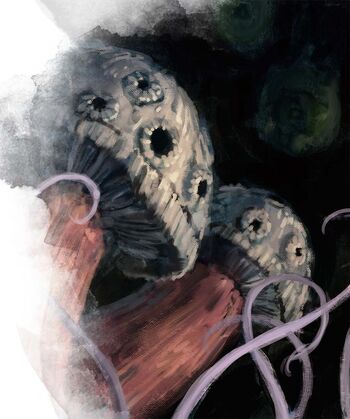
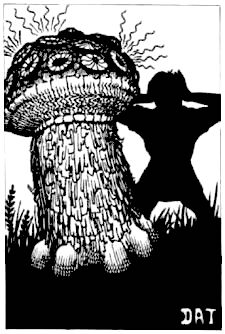
Fungus: Shrieker
Most of the fungi are just... well, sort of rooted to the spot, and aren't exactly as mobile or as dangerous as your goblins and orcs, acting more like, well, obstacles. It's still neat to have, though, because, well, the Shriekers are these giant toadstools with little holes on top of its cap, and the denizens of the Underdark plant these mushroom as the fantasy-cavern equivalent of a guard dog, because these Shriekers... well, they emit a loud, wailing noise like an alarm system. Which isn't harmful at all... until it summons the clan of grimlocks or the tribe of kobolds that have planted the Shriekers for the express purpose of making life hell for you, the adventurer.
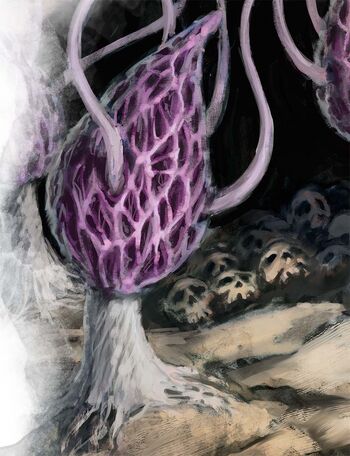
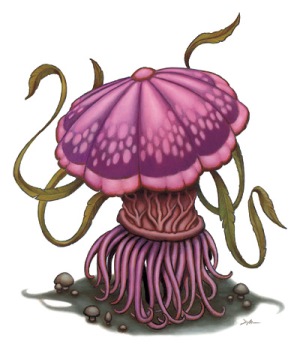
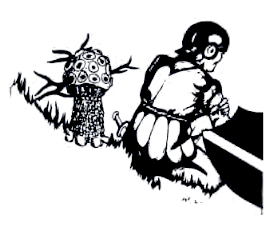
Fungus: Violet Fungus
What's more dickish is that the Shrieker in the original edition was completely indistinguishable with the Violet Fungus. Look at the artwork, they're essentially identical toadstools with little holes on its cap. Subsequent editions have, of course, made the Violet Fungus look a bit more unique, from the ephemeral, almost animal-like jellyfish-esque 3rd edition one, to the Morel-Fungus-inspired 5th edition one. Where the Shrieker is content to just cry and cry and cry, the Violet Fungus will extend its tentacles which will rot whatever it touches, as a way to reproduce and to feed.
Again, not a whole ton to really say about these, and while subsequent editions have thankfully toned down the dickish, trollish aspect of 1E fungi, I do like that sometimes, a bunch of completely neutral fungi could serve as an adversary.
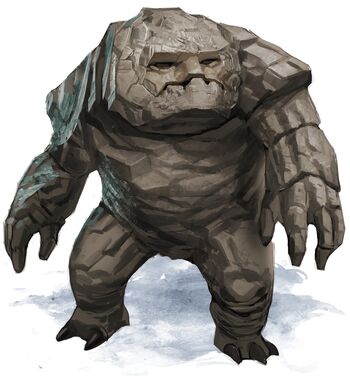
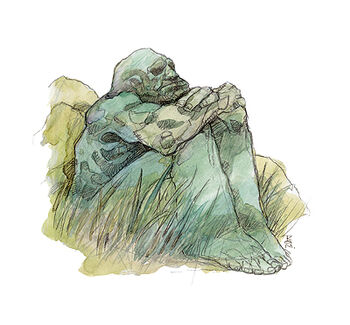
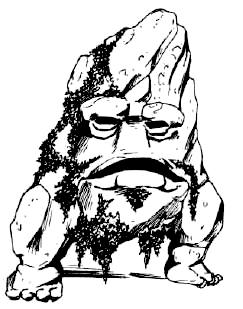
Galeb Duhr
From the 3rd edition onwards, the Galeb Duhr have been portrayed as stout humanoids made out of stone with slightly angry faces, but holy shit, look at that absolutely adorable angry little rock-face with two baby feet from the 1st edition! The original concept of the Galeb Duhr is less of a rock-man and more of a sentient rock. It's so adorably goofy, it's like the reverse-world Geodude. Honestly, I kinda wished they had kept some of the original's goofy charm. Not that I don't mind the modern-day Galeb Duhr, which look pretty neat, but there's just something unique about just being nothing but a rock face with feet. After all, it's a rock-being, why would it confirm to bipedal standards? They're basically elemental beings who are actually sentient, either being summoned from the elemental plane of earth or naturally manifesting in any material-plane area that's rich in rocks. They're neutral dudes that are just there, happy to do their day job of protecting some sacred area or dungeon that they're created and/or summoned in order to perform. Most of the time, though, the Galeb Duhr is a pretty mellow, happy creature that will be happy to assist anyone who it doesn't perceive as a threat. Not the most creative monster, especially when it has moved from being a wacky waddling rock into a generic stone-man, but a charming one.
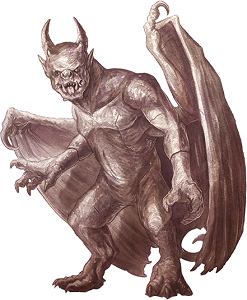
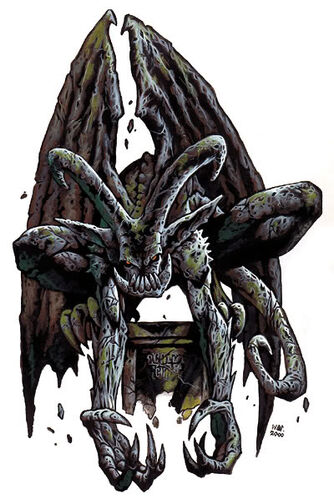
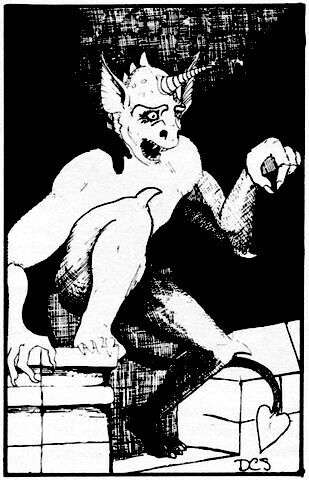
Gargoyle
Gargoyles are a very, very common monster trope thanks to their usage in medieval architecture and the legends that sprang out of it, and, again, is another one of those monsters that's easily understandable by most players. I absolutely love 3E and 4E's far ganglier and demonic-looking artwork, though, and while 5E does have an art piece that looks a bit more realistic as a 'proper' gargoyle... it's a lot less interesting, y'know what I'm saying? Basically, in the world of D&D (at least in the newer editions; between settings and editions gargoyles sort of move back and forth between being golem-like magical creations or elementals), these Gargoyles are naturally occurring earth elementals, and the gargoyle-statues used in architecture are carved in homage of these. Why you'd homage a bunch of ill-mannered, chaotic evil stone demon-men is kind of confusing, but the living gargoyles take great delight in basically masquerading as one of their inanimate kin, and then just bursting out and revealing that it's actually alive. Being a stone creature, it can basically hold a pose and practically be indistinguishable from a real statue for years, which makes gargoyles, well, perfect sentries for wizards and lords. Apparently, the gargoyles are created from the shards left in the wake of the earth elemental prince Ogremoch, who ended up creating these flying stone creatures specifically to mock the air elementals. Overall... it's a gargoyle! It's nothing too spectacular or innovative, and I do like it that D&D (or, well, at least the 5th Edition) doesn't try to reinvent the wheel on many of these classic mythology-inspired monsters.
Genies
What the Western world know as "genie" is very much blurred from what the original Middle-Eastern jinn (or djinn, or djinni) actually is. Thanks to a certain story featuring a street rat adapted into a widely-read book, which in turn is adapted into a popular Disney movie, genies have basically been almost pigeonholed into helpful wish-granting little godlings that hang around in lamps. And while Aladdin's genie is certainly iconic for a reason, that'd like portraying all dragons in a setting as a carbon-copy of Mushu, or all ghosts in a setting as being exactly like Slimer, y'know, or all demons to be exactly like that character from the Powerpuff Girls. "Jinn" is a term that's more akin to how the Western world would describe a 'spirit' of sorts. And I do like that while the original 1st edition Monster Manual only introduced the djinni and the efreeti (the ifrit a type of jinn), they were eventually spun out and given a completely neat little niche. Making them something like spirits or demons would shoehorn into an already crowded territory, so with the addition of a couple additional genie sub-types, D&D would codify the genies as basically the main sentient inhabitants of the Elemental Planes, making the elementals have their own sentient races as opposed to just being mostly living flame and living tornadoes. Their origins vary from just being a race that's born in the Elemental Plane, or the melding of the soul energy of a creature from the material plane with the elemental force, creating a wholly new creature out of it.
And genies are highly powerful in their mastery of magic, and only gods and god-like beings can fight against the genies in equal combat. Supposedly, anyway -- in most editions, they tend to be middle-tier enemies. There's no stopping you from making a 'genie lord' or a 'noble genie' able to rewrite reality to their whim, though -- after all, Wish is the mightiest spell in Dungeons and Dragons. And while not all genies are able to do this, the mightiest of them can cast Wish, which is why the genies are targets of many mages and sorcerers who seek to subjugate them and bind them with magic. Also, while not all genies are evil, the 5E Monster Manual does characterize them as egomaniacal slavers... which is kind of odd since half of the four main genie types described afterwards lean more towards being neutral or even good.
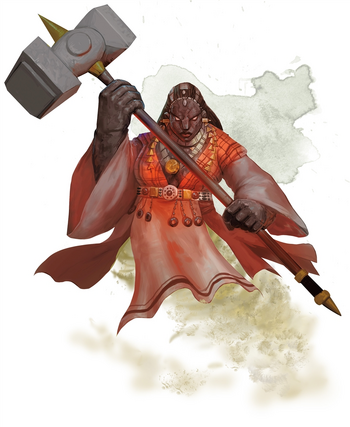
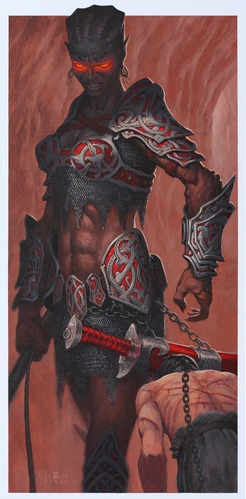
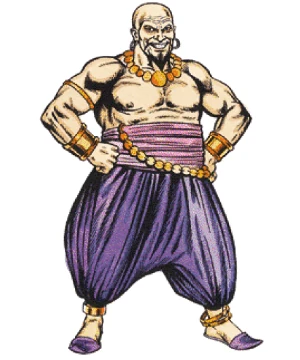
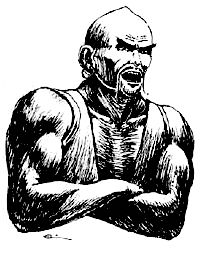
Genies: Dao
The Dao is the genie representative from the plane of earth, and it's always consistently portrayed as neutral evil. It's also the only one out of the four 'basic' genies to not take its name from an Arabic jinn type. Originally, in the first two editions of D&D, all the genies are just depicted as, well, dudes wearing stereotypical Arabian clothing, making them look like background characters in Sinbad or something, but eventually they got different-looking appearances. The Dao's never really consistent, though, going from a noble-looking Greek dude in 3E, to an almost demonic, armoured woman in 4th Edition, to a lady with a massive hammer and a dress with the lower body that's a column of sand. I don't really think I have a preference, if we're being honest. They're genies, they can look however the fuck they want. The Dao are noted to be particularly greedy and covetous, wanting to collect as many expensive gemstones as possible, amassing slaves and creating massive palaces through the huge rock formations in the elemental plane of earth. Apparently, the Dao are easily lured thanks to their greed, and wizards are known to trap them in iron flasks and gemstones.
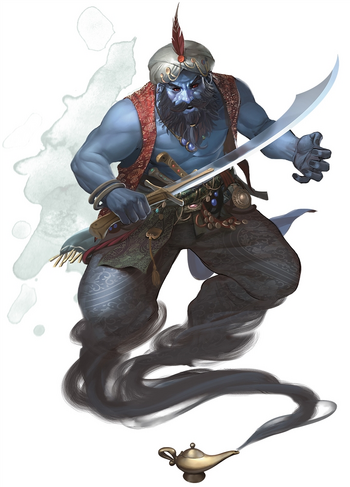

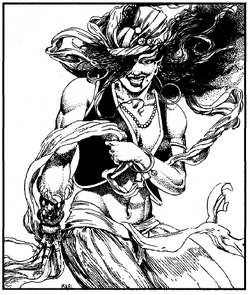
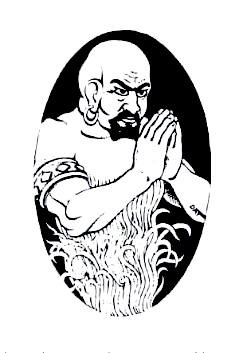
Genie: Djinni
Borrowing their name from the default name for these Arabic spirits, the D&D Djinni is also the one that's the most inspired from the 101 Tales of Arabian Nights genie, with most modern portrayals giving it a heavy-set body, blue skin and a beard. The djinni are also the most helpful out of the genies, ranging from chaotic good in most editions, and being unaligned at worst. They hail from the plane of air, living in huge palaces and dining on good food and whatnot. They're mischievous towards humans, and the djinni tend to not want to deal with other genies (especially the dao) due to their cruelty. They keep slaves, sure, but they treat them with kindness and will gladly part with them if there's good enough reason. Of course, just because they're nice doesn't mean they're harmless, because they can control the weather at their fingertips, riding powerful whirlwinds and manipulating massive storms. The Djinni also interestingly believe that "servitude is a matter of fate", and it is this worldview that cause them to usually just shrug off being, say, bound in a lamp and forced to grant wishes to be just bad luck, bro. Just get your wishes out of place, and don't, y'know, imprison or enslave the djinni, otherwise you'll earn the wrath of a reality-manipulating air elemental. It's honestly a pretty interesting world-view, where they're all right with temporary subjugation, but will make your life a living hell if you try to go for indefinite imprisonment.
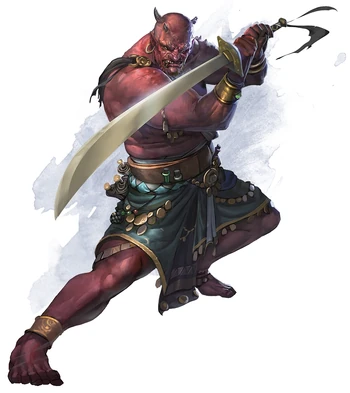
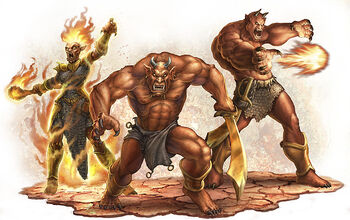
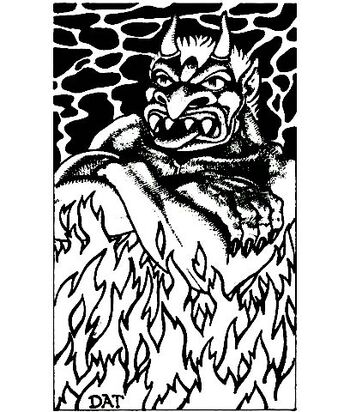
Genie: Efreeti
The Efreeti is based on the Ifrit, a type of jinn known to be associated with death and sometimes even identified in myths as a type of Shaitan, or demon. Ifrits show up a lot in Middle-Eastern legends, but is only second to the genie as far as being more well-known to the Western world, because they show up as antagonists in multiple stories in 101 Arabian Nights, and some of the ifrit there use fire. Which is why, of course, D&D's efreeti are associated with the plane of fire! More or less consistently portrayed as hulking, shirtless musclemen with flaming scimitars, the efreeti are pretty cool-looking, and are characterized most of the time as lawful evil beings, befitting their Darth-Maul-esque visage. They're still able to transform their lower body into flames, to get that classic elemental/genie body shape, and they're cunning and ruthless, and hold a grudge against anyone who tries to force them into servitude... but, of course, their own slave-driving is totally fine. The efreeti are also characterized (particularly in 4E) as being particularly organized, living in a City of Brass and having an organized military.
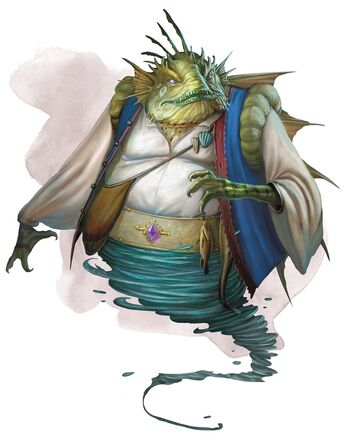
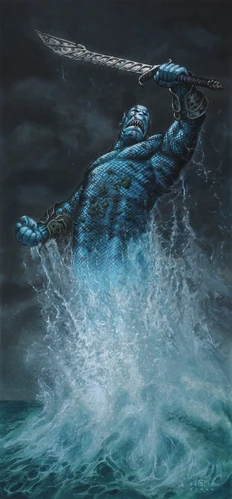
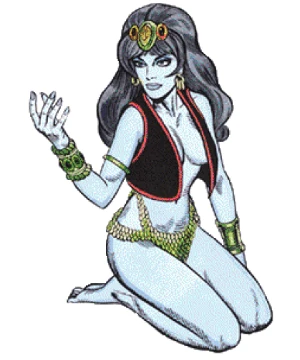
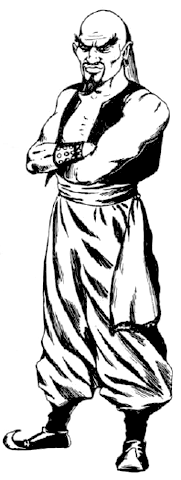
Genie: Marid
Taking their name from a type of jinn or shaitan in Islamic traditions, the Marid in D&D is actually characterized as being pretty benign, being chaotic neutral. Representing the plane of water, I do find it how interesting the Marids have transformed over the multiple editions. 1E Marid shares the same generic Sinbad background extra that the dao and djinn look like, 2E Marid is kind of a stripper-y blue-skinned chick, while 3E and 4E basically takes the normal genie body shape and slapped some water onto it. And then 5E gives us a random reinvention of the Marid, turning it into this massive, opulent frog/fish-faced dude with flowing robes and a swirling tornado of water as its lower body. What? I'm not complaining, though, a weird frog-fish-faced genie is certainly far, far more distinctive than "just the djinni, but with water instead of air". Which is awesome! Personality wise, the marids honestly aren't super different from the other genies, but they are a bit more capricious, love to tell stories (often peppered with bullshit) and have a huge superiority complex, even compared to other genies. They love their titles, and apparently "the race is awash in shahs, sultans, muftis and khedives". They don't really treat humans maliciously like the dao and efreet, but they're not kind like the djinni either -- their self-inflated ego basically makes them hard to treat these humanoids in equal terms.
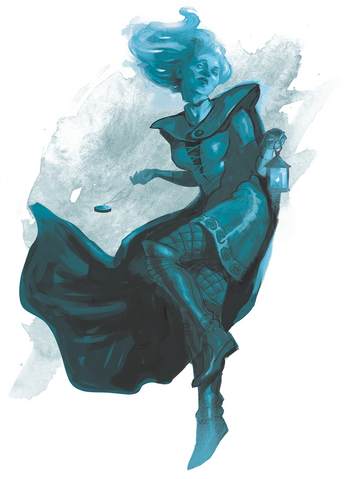
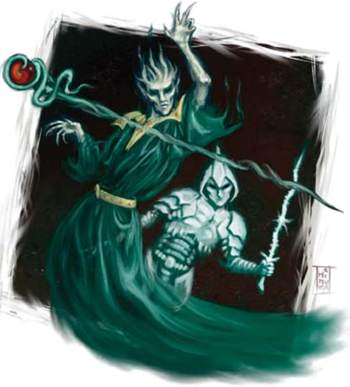
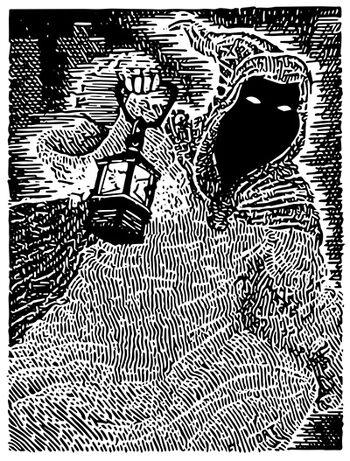
Ghost
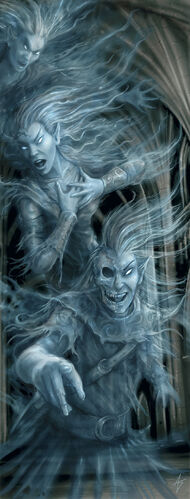 Doing these monster reviews and being a huge aficionado about general fantasy RPG monster sourcebooks and whatnot, it always struck me that one of the most repetitive monsters are ghosts. Specters. Banshees. Poltergeists. Wisps. Revenants. Shades. Phantoms. Spirits. These will always show up in every conceivable fantasy setting, because, well, ghosts in general are basically things that are common in every culture. The fear of death is omni-present among humanity, and even scarier than that is the supernatural, that somehow, there are these twisted spirits from beyond the grave that's able to cheat even death, staying trapped in the material realm for some reason or another. D&D being D&D, we're going to see a bunch of these otherworldly beings down the road (and in fact, we've covered the Banshee), but the D&D ghost keeps things very basic. It's a transparent, floating humanoid that is the soul of a once-living being, it can float, it can pass through walls, it causes some supernatural happenings around it, it scares people... and perhaps most annoying, it can possess people. Without getting into gaming jargon... possession is very much annoying and could honestly really fuck up your party.
Doing these monster reviews and being a huge aficionado about general fantasy RPG monster sourcebooks and whatnot, it always struck me that one of the most repetitive monsters are ghosts. Specters. Banshees. Poltergeists. Wisps. Revenants. Shades. Phantoms. Spirits. These will always show up in every conceivable fantasy setting, because, well, ghosts in general are basically things that are common in every culture. The fear of death is omni-present among humanity, and even scarier than that is the supernatural, that somehow, there are these twisted spirits from beyond the grave that's able to cheat even death, staying trapped in the material realm for some reason or another. D&D being D&D, we're going to see a bunch of these otherworldly beings down the road (and in fact, we've covered the Banshee), but the D&D ghost keeps things very basic. It's a transparent, floating humanoid that is the soul of a once-living being, it can float, it can pass through walls, it causes some supernatural happenings around it, it scares people... and perhaps most annoying, it can possess people. Without getting into gaming jargon... possession is very much annoying and could honestly really fuck up your party.
Ghosts in D&D have been relatively consistently portrayed as spirits that are bound to either a location, person or object, trying to complete some unfinished business, playing off a lot of common tropes with ghostly stories. And so that your DM can have a variety of ghosts to pick from, the Monster Manual suggests that ghosts are very variable thanks to the circumstances that created them (and to homage a lot of depictions of ghosts in the mainstream media). Some are unaware that they died and go about their daily routines, repeating them over and over. Some are trying actively to avenge their death, or seek aid from the living. Some are just straight-up evil. There's a neat bit of roleplaying uniqueness becasue the ghosts have a special weakness if you can figure out how they died in the first place, which I don't think is a trope that's commonly applied to ghosts? And, of course, there's the whole "please help resolve my unfinished business" deal that could apply to either antagonistic or helpful ghosts. I've always disliked the fact that ghosts and specters tend to basically just end up as "hey, beat up these guys with magic weapons and make them even deader", which really makes them feel mundane for what would've otherwise be a terrifying, spiritual threat. I always appreciate DM's that are able to integrate the ghosts and ghost-like undead in a way where fighting them involves something more. The 5E Manual does give us a bunch of hooks, and I appreciate that.
Overall, again, a pretty basic collection of common ghost tropes, pretty fitting for what's basically the 'basic' ghost of the setting. Which, depending on how you set it up, could either be a particularly annoying encouter, an NPC beseeching you for help, or just a bunch of 'seasoning' minions controlled by a vampire lord or something.
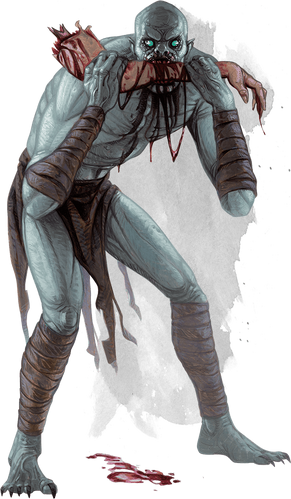
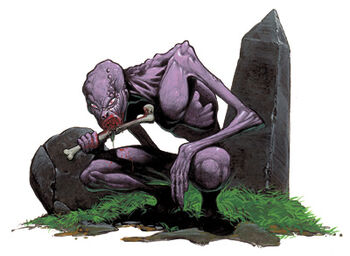
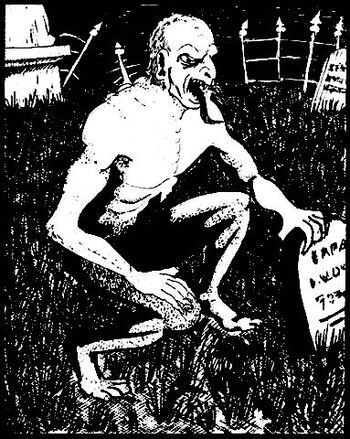
Ghoul
"Ghoul" is one of those monsters that have such a wildly different interpretation depending on the media. Click here for Wikipedia's list of ghoul depictions in popular culture, and to quote TVTropes, our ghouls are different. The original Arabic myths of ghouls are basically just hideous human-like monsters (or monstrous men?) that lures travelers astray, and somewhere along the line, the legend of the ghoul was codified in Arabian Nights as a cannibal that feasts upon corpses. The D&D ghoul basically runs with an adaptation of this, making ghouls into a type of gangly, monstrous undead that lurk in crypts and catacombs with a hunger for flesh. Specifically, dead flesh. And your bunch of foolish adventurers that wander into their territory? Well, if they're not dead yet, the ghouls are more than willing to make you dead. And they're basically the 'rabid dog' compared to the skeletons and zombies being more clueless. They're mindless, but are driven so much by primal hunger that it makes them a bit more of a problem to fight compared to others. Unlike zombies, their flesh doesn't rot, and they just stay in this perpetual state of, well, I guess 'true' undeath? In D&D lore, ghouls are specifically tied to the demon lord Orcus (the one who's all about the undead), and, uniquely, elves are immune to many of the debilitating effects that ghouls are able to unleash.
Ghast
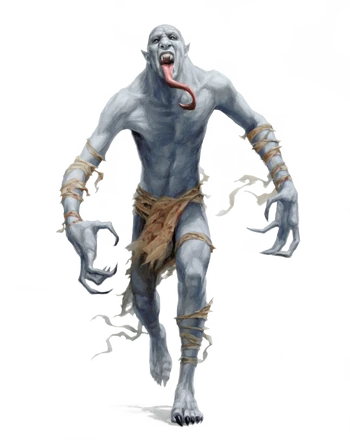 Being an RPG, of course most 'base' monsters have a more powerful version of themselves. But ghouls are one of the few whose stronger version isn't something with an adjective slapped onto it, but rather a creature with its own unique name, the ghast. We don't really learn much about ghasts, though, despite being around since forever. Their origins vary -- in some editions, they are simply ghouls that are more powerful because they were made from the corpses of stronger warriors; or, in 5E, are directly created by Orcus through infernal intervention. The ghasts are basically far stronger than ghouls, able to command the others, and one feature that the ghasts consistently have throughout their numerous appearances is their foul, foul stench. Ghastly!
Being an RPG, of course most 'base' monsters have a more powerful version of themselves. But ghouls are one of the few whose stronger version isn't something with an adjective slapped onto it, but rather a creature with its own unique name, the ghast. We don't really learn much about ghasts, though, despite being around since forever. Their origins vary -- in some editions, they are simply ghouls that are more powerful because they were made from the corpses of stronger warriors; or, in 5E, are directly created by Orcus through infernal intervention. The ghasts are basically far stronger than ghouls, able to command the others, and one feature that the ghasts consistently have throughout their numerous appearances is their foul, foul stench. Ghastly!
Giants
Another group of creatures that's almost sure to get a whole load of sub-types are the giants. And, again, it's easy to see why. Many mythologies tend to feature giants as antagonists and villains, and many different mythologies also tend to feature different kinds of giants.... and there's just something that is especially satisfying and primal about fighting a creature that's essentially you, but magnified multiple times in size, y'know? Like dragons and demons and devils, older editions tend to have expanded bestiaries about other types of giants and whatnot, but the 5th Edition Monster Manual basically just has the six of the original giants featured in 1E AD&D's Monster Manual: Cloud, Storm, Hill, Stone, Frost and Fire, and generally, they stylistically draw a lot from a mish-mash of Grecian and Nordic myths.
Again, I'm not going to go too deep into the specific lore, since they differ from setting to setting, but mostly, the giants tend to be portrayed as sort of the progenitors, beings who once ruled the world with their ancient civilizations... which eventually fell apart, reducing the giants to separate clans and tribes, while the ruins of their civilization are consumed by time, or are claimed by other creatures (like dragons, who they hate) to be used as convenient dungeon settings. Unlike the dragons (or demons, or devils, or elementals), the disparate types of giants all view each other as kin despite their physical differences, and they have a system called the Ordning, basically a caste system that giants obey almost unquestioningly. Basically, based on this status, the storm giants are the most powerful of the giants, followed by cloud, fire, frost, stone, hill (and each tribe has their own Ordning based on the values that the specific giants revere); and then at the bottom rung are other, lesser "giantkin" like ogres, fomorians, cyclopes, trolls and ettins. That's a lot of giants! And that's before we get into the giants' gods. In 5E, each giant type had their own patron deity, the sons of their primary god, Annam All-Father, and their religion believes that Annam had became so disgusted by their race as a whole, and that he will only return when the giants are whole once more and have returned to their original glory.
I've never really found these guys to be particularly as 'cool' as monster designs, although the couple of times that my D&D group faced against giants, they tend to be insanely harrowing encounters. Their lore is also pretty neat. Giants honestly tend to run the gamut of allegiances, and aren't 'locked' into a single category like most other races, with any giant you meet potentially being an evil, xenophobic, spiteful warrior, or just a gentle dude living in a remote ruin who might just be a wee bit ignorant about the customs of us tiny folk.

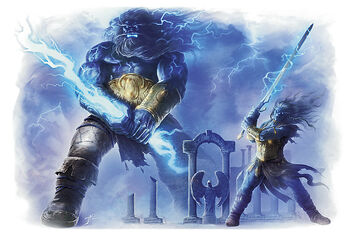

Storm Giant
 Playing off real-life mythology, some of the mightiest 'leader' gods have mastery over the skies and storms, because our ancestors viewed these thunderstorms as something so immensely impossible that truly only the mightiest of gods like great Zeus or mighty Thor can hurl thunderbolts and summon massive hurricanes. Storm Giants, thusly, are the mightiest of the giants, and nearly all of their artwork make their mythology-inspired origins pretty damn clear. The Storm Giants, of course, control storms, and they're actually chaotic good, in stark difference to the other giants. They don't really keep their brethren in line, though, living as reclusive hermits as prophet-kings, either below the sea or above the surface of the world in mountains or the cloud-cities of their cloud giant kin. Despite being mighty beings that could affect entire continents with their fury, storm giants (at least in 5E) are characterized as mostly playing a long game, trying to divine Annam's will in cosmic signs and acting more as prophets and seers than actual active participants in the world, because, well, they've watched the same song and dance so many times among the mortals, so why bother intervening? So much of storm giant culture basically revolves around them interpreting signs.
Playing off real-life mythology, some of the mightiest 'leader' gods have mastery over the skies and storms, because our ancestors viewed these thunderstorms as something so immensely impossible that truly only the mightiest of gods like great Zeus or mighty Thor can hurl thunderbolts and summon massive hurricanes. Storm Giants, thusly, are the mightiest of the giants, and nearly all of their artwork make their mythology-inspired origins pretty damn clear. The Storm Giants, of course, control storms, and they're actually chaotic good, in stark difference to the other giants. They don't really keep their brethren in line, though, living as reclusive hermits as prophet-kings, either below the sea or above the surface of the world in mountains or the cloud-cities of their cloud giant kin. Despite being mighty beings that could affect entire continents with their fury, storm giants (at least in 5E) are characterized as mostly playing a long game, trying to divine Annam's will in cosmic signs and acting more as prophets and seers than actual active participants in the world, because, well, they've watched the same song and dance so many times among the mortals, so why bother intervening? So much of storm giant culture basically revolves around them interpreting signs.
Also, Storm Giants can also live anywhere -- including underwater. Which means, that, yeah, sometimes these are the ultimate embodiment of sea storms and the like that you meet in the ocean, like some mighty figure out of Greek myth.

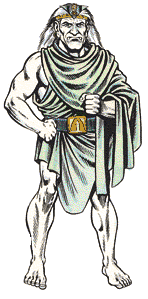

Cloud Giant
The Cloud Giant honestly feels like it draws its inspiration from a specific myth or legend, but I can't figure out where. The Cloud Giants live on either high mountainpeaks, or on top of solid clouds, because of course solid clouds exist in the D&D world. Apparently, these solid clouds were what remains of what was once a far larger network of what's essentially cloud-islands, which is a common recurring theme in various different real-life mythologies. They basically look down literally on the world from their airy thrones, able to use their mastery over the elements to manipulate weather and even transform into clouds of mist and fog. They're basically aloof and detached, and since they're quite literally looking down upon the rest of the world, tend to view others as lesser than them... and, well, since their place in the ordning is basically second only to the storm giants, it's hard to blame them.
The 5E Manual also basically pinpoints the cloud giants as being at least partially influenced by Jack and the Beanstalk, because cloud giants are apparently extraordinary gardeners, and the massive crops from their fields 'lead to tales of magic beans'. The kinder ones among them might be predisposed towards sharing this with the humanoids that it views to be its 'charges'. The way the cloud giant clans decide which ones are higher in social standing basically depends on their wealth, and how they display their wealth. They're not just hoarders, they're connoisseurs. They're basically a race full of those rich, pompous dudes living in private mansions bragging about their latest custom private jet or custom-built villa or whatever. And also, apparently they entertain themselves by betting on events, so... yeah, exactly like decadent rich folk. Honestly, I've never really thought much about these cloud giants until re-reading their entry for the Monster Manual. I'm a fan!

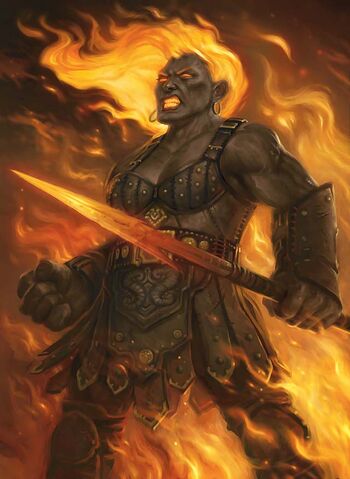

Fire Giant
I'm actually impressed with the amount of words that the 5th Edition Monster Manual devotes to the giants, giving them as much, if not more, write-ups in comparison to dragons or fiends. I still don't find them super interesting, although I do really like how 5th Edition gave us a big top-heavy Ganondorf as the fire giant. Significantly lower on the giants' social rung, the fire giants are basically what you expect from a 'fire giant'. They live in volcanoes and fortresses, they have fire powers, they are great smiths, and their entire culture tends to revolve around war and combat. I do like the description that the fire giants are also shrewd tacticians, and many people underestimate them for being angry rage-beasts. And they are that, too, certainly, but they're not dumb. They're not the most interesting thing in the Monster Manual, honestly, but they do have cool artwork and a pretty neat description of their society. These newer Sourcebooks, thanks to page economy, tend to really skimp on trying to describe the civilization of the more intelligent races, and we get some surprisingly neat, verbose ones for the various giants!

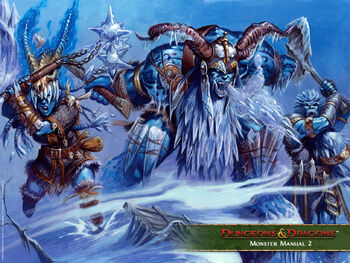

Frost Giant
Obviously drawing inspiration from the Jotunn of Norse legend, the frost giant basically looks exactly what you'd expect from the pages of any book detailing Thor -- be it Marvel comics or more mythologically-accurate retellings of the myths. Muscular, blue skin, massive beards, Viking helmets... yep! Lower than the fire giant on the giant totem pole, the frost giants are what you expect from a race of Viking giants. They are warriors and raiders, they live in the snow, and I do love the description of the villages that are left in the wake of frost giant raids -- not finding any use in gold or money, they destroy things like farms, storehouses and smithies, in particular. They're giant ice-breathing vikings! Not much to go on here. Both fire and frost giants are considered always evil, so yeah, these guys, as well as the hill giants, are common adversaries depending on the setting of your campaign.

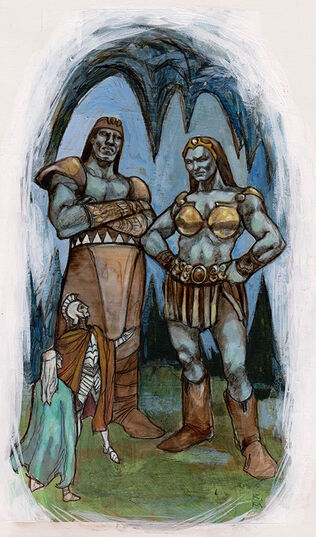

Stone Giant
I really don't have much to go on about the neutral-aligned stone giants. They're lankier, have skin made out of stone, and they live in caves as reclusive, peaceful hermits. And they love their little pet bears, apparently, something that the 5E Monster Manual threw in presumably as a reference to its original 1E artwork. Where the fire giants forge weapons of war, the stone giants are more peaceful and are stonecarvers and artisans, believing that carving shapes out of stone honour their god... and even in battle, they seek to basically utilize art. Sure, they are throwing stones at the humanoids attacking their lair, but they are doing artistic lobs, y'know? Just imagine these stern, stone-faced dudes striking an epic JoJo pose as they artfully twirl and toss rocks to turn a human into a blood paste. Interestingly, the stone giants have such an odd view of the world that they view the world outside their underground homeas as basically dreams where nothing is entirely true, and that's why they sometimes behave erratically and destructively, because, well, it's a dream, so why bother? Honestly, it's a very interesting little detail that makes me really appreciate these guys a lot more.

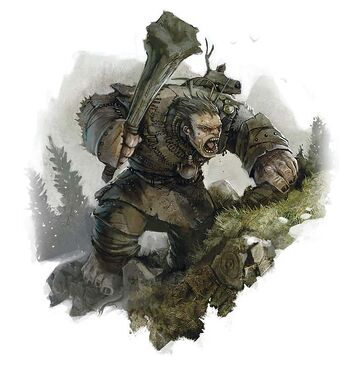

Hill Giant
The lowest of the true giants, the hill giant... is just a huge hungry dude! Depending on the edition, he's just some dude, a very muscular dude, or a pot-bellied dad. Honestly, the only thing that really separates it from something like an ogre is its size and strength, and the fact that in 5E they're super-duper hungry. The Monster Manual just basically goes on and on in describing these dudes as brutish giant thugs that only live and survived this long because of their massive physical strength, and don't even realize that there's a system like the ordning, only obeying the other giants because they have powers that they don't and are clearly stronger. Adorably, the Monster Manual also note that the hill giants are so dumb that they could be fooled by "a group of villagers hiding under a blanket and standing on top of one another, holding a giant pumpkin head".
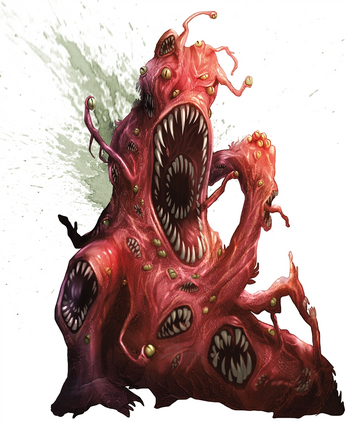
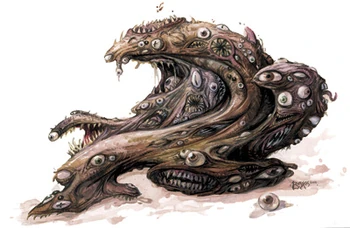
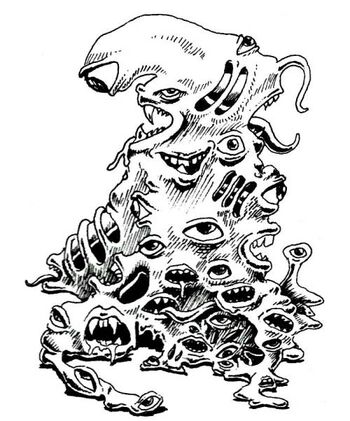
Gibbering Mouther
How GLORIOUS is this thing? The Gibbering Mouther is easily one of my favourite monsters the first time I cracked open one of these Monster Manuals. They showed up in the 1st Edition Monster Manual and has consistently shown up in every other Monster Manual since, rightfully being one of the 'classic' D&D monsters that's held as one of its signature monsters. And what's there not to love about these things? Giant formless flesh-blobs of tentacles that's filled with eyes and mouths of different shapes and sizes, the Gibbering Mouther looks Lovecraftian yet hilarious at the same time. There's the inherent horror of something so bizarrely monstrous and indescribable, but even the more serious modern artwork do find a lot of fun in the sheer inherent goofiness of a bunch of eyes and mouths on a blob of goop.
Obviously, the Gibbering Mouther is an aberration, but it's not exactly evil per se. The 4th Edition characterizes the Gibbering Mouther as the most basic, most primal manifestation of the Lovecraft-inspired Far Realm, but in all other editions, the Gibbering Mouthers are just basically the most foul creation of foul magic, either born out of the magic itself, or actual liquefied matter of a bunch of victims. Whatever the case, the Gibbering Mouther basically just gibber incoherent madness from its many mouth as it goops around like an amoeba to consume anything in reach. It speaks in a couple dozen different voices, and this effect is so horrifying that most creatures that hear this will flee in terror, or be paralyzed in the sight of What Should Not Be. Honestly, the Gibbering Mouther is just so equally charming and hilarious at the same time. I really don't have much to say, the Gibbering Mouther is easily one of the creepiest and funnest design in the Monster Manual, and to this day, it still remains one of my all-time favourite monsters.
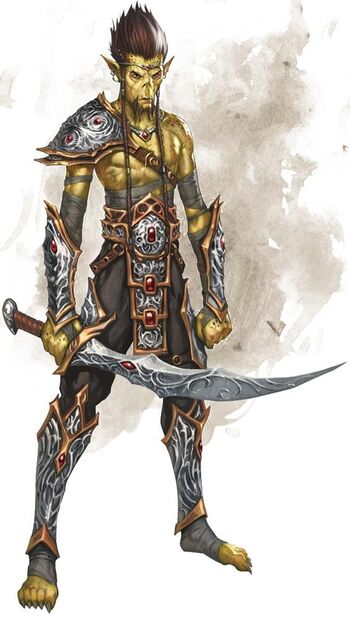
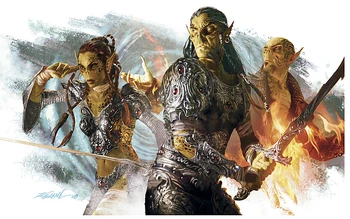
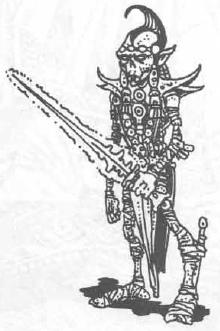
Githyanki
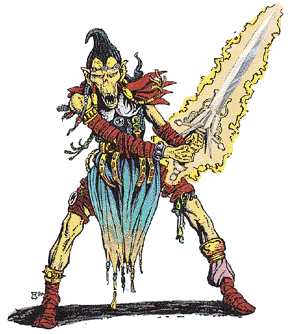 Y'know... I've never really cared all that much about the Gith, and I'm not quite sure why. Introduced in the Monster Manual II of the first edition of D&D, the Gith are a race that once lived on a different plane, who fought and liberated themselves against their Mind Flayer slavers, and became two unique cultures -- the war-like Githyanki and the contemplative Githzerai. I'm not quite sure why I never really took to the Gith despite not minding many of D&D's other original humanoid societies. Maybe it's just because I've never really met them in a campaign? They're like these noseless, yellow-skinned quasi-elves with fancy hairdos, often with psionic powers, and the base concept of their race's split into two is pretty interesting -- after the heroine Gith freed the race from their Illithid masters, the race ended up breaking apart in infighting, from Gith's supporters, to others who supported another leader, Zerthimon, who condemned Gith's martial law as another form of slavery.
Y'know... I've never really cared all that much about the Gith, and I'm not quite sure why. Introduced in the Monster Manual II of the first edition of D&D, the Gith are a race that once lived on a different plane, who fought and liberated themselves against their Mind Flayer slavers, and became two unique cultures -- the war-like Githyanki and the contemplative Githzerai. I'm not quite sure why I never really took to the Gith despite not minding many of D&D's other original humanoid societies. Maybe it's just because I've never really met them in a campaign? They're like these noseless, yellow-skinned quasi-elves with fancy hairdos, often with psionic powers, and the base concept of their race's split into two is pretty interesting -- after the heroine Gith freed the race from their Illithid masters, the race ended up breaking apart in infighting, from Gith's supporters, to others who supported another leader, Zerthimon, who condemned Gith's martial law as another form of slavery.
The Githyanki are those that follow Gith's more savage teachings, being identified as lawful evil. They are also some kind of space raiders, going through planes and astral vessels and riding red dragons as they plunder other worlds. They're particular dicks that leave just enough of the worlds they plunder to rebuild... so they can go back and raid it again and again. What dicks! They serve Gith's successor, the lich queen Vlaakith, and the Githyanki are held in a rigid caste system and are super-duper xenophobic. They also basically embody the psionic powers in D&D settings, and their combat culture revolves around the ability to summon and wield a psychic silver blade -- and these silver blades are a very, very important part of their culture. Also, thanks to an ancient deal that Gith struck with Tiamat, the Githyanki society has their own massive brood of red dragons that they ride as mounts.
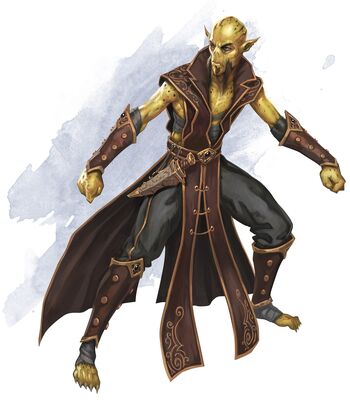
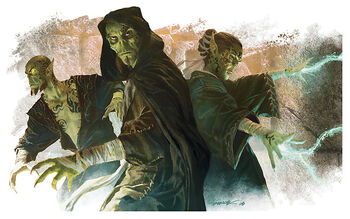
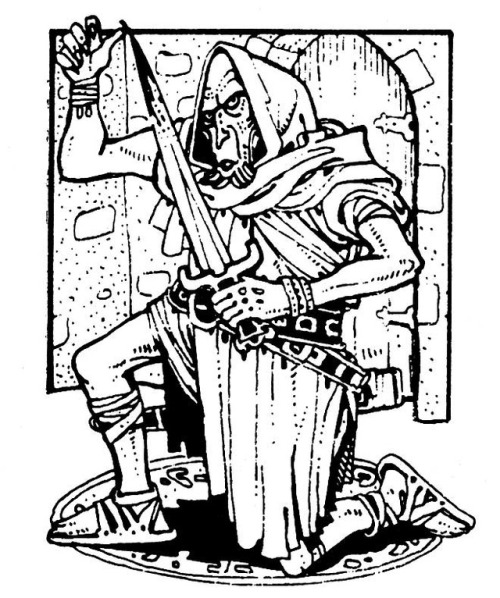
Githzerai
Githzerai, meanwhile, are lawful neutral, and are philosophers and benevolent thinkers, pursuing lives of order. They're also untrusting of outsiders, although not to the extent of their Githyanki cousins. They basically hang out the plane of Limbo as nomads, content to live their life in peace. In combat, they basically go for a mind-over-matter philosophy, tending to use their psychic powers to disable opponents. They're an entire race of mostly-benign psychic monks, a whole race of Yodas, I guess? Both Githyanki and Githzerai really hate each other, but their worst enemies are the mind flayers. Githyankis slay mind flayers as a rite of passage, and only warriors that have bloodied their blades with illithid blood are allowed to rejoin their people, whereas the Githzerai tend to organize large raids to crack down on illithid societies.
And... yeah, I'm genuinely not sure why I am just so indifferent about the Gith. They're honestly pretty dang cool, I like the world-building aspect behind them, and I certainly don't hate them, but I am hard-pressed to really talk a lot about them or gush over them the way I do other races. I guess the weird planar-hopping thing just felt kinda off in a D&D setting? And it really shouldn't be, since so many other monsters and aspects of D&D also feature jumping from one realm to the next, but I dunno. Just not a big fan, I guess.
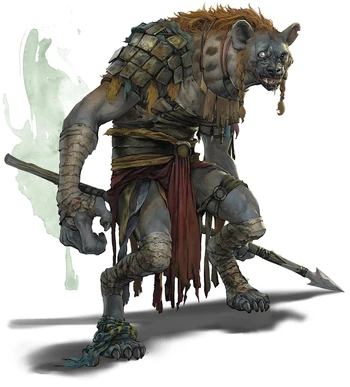
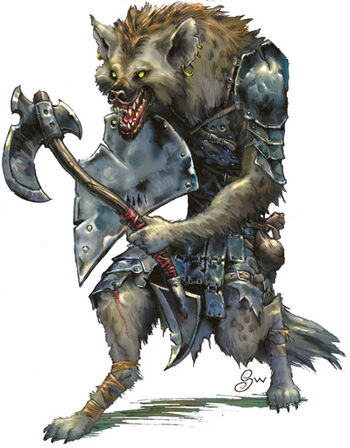
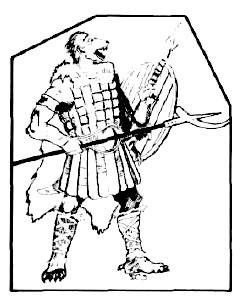
Gnoll
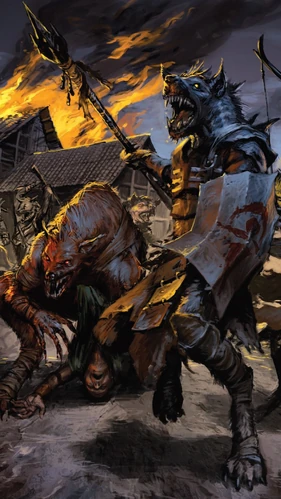 I was somewhat more lukewarm about the massive chunk of giants and gith that came before this, so it's neat that I'm going to end this article with one of my all-time favourite classic monsters, the Gnolls. And the gnoll really isn't the most original race concept ever, very loosely taking inspiration from the half-gnome, half-troll gnole of the Book of Eonder. D&D's Gnolls, and the various fantasy settings that copy the gnolls, are savage hyena-men, who are brutal monsters that raid villages, and also are just challenging enough for lower-level players without being too threatening. And I'm not sure what is it about hyenas that got them typecast as villains all the time, but it kinda works? A hyena's mutt-like appearance and general gangliness does instantly translate to a pretty threatening, nasty-looking silhouette. And that's before you work in the colouration, the sinister cackling, and the over-exaggerated evil reputation as scavengers. The gnolls are honestly pretty fun! They're stronger than things like kobolds and goblins, and each gnoll is individually enough of a threat. It's like fighting a dire wolf or a hyena, but they're on their legs, able to wield weapons, and able to reason. And that's without going to the gnolls that can actually do more than just generic mauling! 5E has the Gnoll Pack Lord as the buffed-up member of the tribe, and there's the Gnoll Fang of Yeenoghu, who is blessed by their patron demon-god, Yeenoghu, who allows a particularly victorious and savage gnoll to be possessed by one of his demonic spirits, transforming them into more savage, demonic forms that are actually considered fiends by the game, and is able to transform hyenas into gnolls.
I was somewhat more lukewarm about the massive chunk of giants and gith that came before this, so it's neat that I'm going to end this article with one of my all-time favourite classic monsters, the Gnolls. And the gnoll really isn't the most original race concept ever, very loosely taking inspiration from the half-gnome, half-troll gnole of the Book of Eonder. D&D's Gnolls, and the various fantasy settings that copy the gnolls, are savage hyena-men, who are brutal monsters that raid villages, and also are just challenging enough for lower-level players without being too threatening. And I'm not sure what is it about hyenas that got them typecast as villains all the time, but it kinda works? A hyena's mutt-like appearance and general gangliness does instantly translate to a pretty threatening, nasty-looking silhouette. And that's before you work in the colouration, the sinister cackling, and the over-exaggerated evil reputation as scavengers. The gnolls are honestly pretty fun! They're stronger than things like kobolds and goblins, and each gnoll is individually enough of a threat. It's like fighting a dire wolf or a hyena, but they're on their legs, able to wield weapons, and able to reason. And that's without going to the gnolls that can actually do more than just generic mauling! 5E has the Gnoll Pack Lord as the buffed-up member of the tribe, and there's the Gnoll Fang of Yeenoghu, who is blessed by their patron demon-god, Yeenoghu, who allows a particularly victorious and savage gnoll to be possessed by one of his demonic spirits, transforming them into more savage, demonic forms that are actually considered fiends by the game, and is able to transform hyenas into gnolls.
 In D&D lore, the gnolls trace their origin to the demon lord Yeenoghu, who's as vile and brutal as his hyena-men children. The gnolls themselves are basically nomadic tribes that plunder villages at random, pillaging and killing random small settlements and targeting smaller villages that tend to not have any sort of protection. While they don't scavenge for dead flesh (they work for their food!) they do scavenge the weapons and clothes of their victims, so that's neat! Gnolls have been kind of one of the more popular races to come out of D&D, and I love them, too -- the gnolls have often been one of the first races to receive the 'monstrous PC race' treatment... which I'm not sure works, and in 5E in particular, canon!gnolls are bloodthirsty and are driven by an innate sense of slaughter and mayhem. But hey, if the drow can have their Drizzt Do'urden, there's no stopping you from making a noble gnoll rebelling from his or her society, and casting off Yeenoghu's grip on their clan, Warcraft-orcs style! Again, the Monster Manual doesn't really characterize them all that much beyond highlighting their barbaric tendencies, but the gnolls do get a lot of love from D&D. For 5E in particular, the gnoll is one of the races to be featured and expanded upon in Volo's Guide to Monsters, describing just how fanatical they are to the art of senseless slaughter and murder, describing multiple variants of super-gnolls touched by Yeenoghu, and noting their superstitious tendencies of seeing signs in everything.
In D&D lore, the gnolls trace their origin to the demon lord Yeenoghu, who's as vile and brutal as his hyena-men children. The gnolls themselves are basically nomadic tribes that plunder villages at random, pillaging and killing random small settlements and targeting smaller villages that tend to not have any sort of protection. While they don't scavenge for dead flesh (they work for their food!) they do scavenge the weapons and clothes of their victims, so that's neat! Gnolls have been kind of one of the more popular races to come out of D&D, and I love them, too -- the gnolls have often been one of the first races to receive the 'monstrous PC race' treatment... which I'm not sure works, and in 5E in particular, canon!gnolls are bloodthirsty and are driven by an innate sense of slaughter and mayhem. But hey, if the drow can have their Drizzt Do'urden, there's no stopping you from making a noble gnoll rebelling from his or her society, and casting off Yeenoghu's grip on their clan, Warcraft-orcs style! Again, the Monster Manual doesn't really characterize them all that much beyond highlighting their barbaric tendencies, but the gnolls do get a lot of love from D&D. For 5E in particular, the gnoll is one of the races to be featured and expanded upon in Volo's Guide to Monsters, describing just how fanatical they are to the art of senseless slaughter and murder, describing multiple variants of super-gnolls touched by Yeenoghu, and noting their superstitious tendencies of seeing signs in everything.
5E stats in the Monster Manual for the creatures we covered here:
You are now reading the article Reviewing D&D Monsters - 5E Monster Manual, Fomorians to Gnolls with link address https://kanakoroku.blogspot.com/2019/10/reviewing-d-monsters-5e-monster-manual.html
Title : Reviewing D&D Monsters - 5E Monster Manual, Fomorians to Gnolls
link : Reviewing D&D Monsters - 5E Monster Manual, Fomorians to Gnolls
Reviewing D&D Monsters - 5E Monster Manual, Fomorians to Gnolls
The original draft of the "dryads to flumphs" article was actually originally "driders to giants", in which I tried to fit as many monsters as possible because I sort of wanted to blaze through the Monter Manual. In the same vein as the Yu-Gi-Oh and Magic: The Gathering reviews, though, I've learned to really pace myself and, well, basically enjoy the smell of the flowers as I go. The whole point of going through these monsters is to showcase my appreciation for the more interesting ones, of course, and to talk about those that draw from specific real-life mythologies and whatnot. While I was admittedly way too verbose in the devils, demons and dragons pages, I'm going to try and basically... stop trying to really make these reviewing monsters fit a certain arbitrary page quota or describe every detail of the creature, and just sort of make it a lot more casual, y'know?And, hey, we're basically almost halfway through the Monster Manual. Woop woop!
Click here for the previous part, covering Dryads to Flumphs.
Click here for the next part, covering Goblins to Kenku.
Click here for the index.



Fomorian
The Underdark basically has a lot of evil, twisted versions of the creatures from the surface world. The Duergar and Derro are are dishonourable and evil slavers, in contrast to dwarves. The Drow are a bunch of cutthroat assassin-cultists, in contrast to elves. The
They do have a neat backstory, though, where they used to be a tribe that attempted to wrest control of the Feywild's magics for themselves, but as anyone knows, fucking with faeries is probably as dangerous as fucking with demons, and the proto-Fomorian giants were all twisted and warped by the faeries' curse, being driven off into the Underdark. They're one of the monsters that keep showing up in every edition, but considering that D&D has no shortage of other giant-kin, the Fomorians always felt just kinda there to me, just malformed, particularly brutal slavers and brutish monsters that live underground. It's a neat, classic monster, don't get me wrong, but I've never really been impressed by it.



Fungus: Gas Spore
Fungi! While the D&D system basically lumps together the fungi as "Plant" type creatures, it's more for the sake of convenience more than anything, the same way that every single not-technically-a-dragon creature is slapped the "draconic" type. And the fungi has been around, bothering players, ever since the inception of the game. The setting and locale that the dungeons tended to be set in -- dark, damp and abandoned -- is just prime material for fungi to grow, so yeah, we've got a whole lot of fungus creatures. The Monster Manual showcases three particular examples in their "Fungus" category, and we're going to go through these three classic D&D fungi!
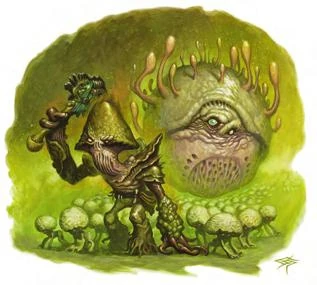 |
| 4E Gas Spore |


Fungus: Shrieker
Most of the fungi are just... well, sort of rooted to the spot, and aren't exactly as mobile or as dangerous as your goblins and orcs, acting more like, well, obstacles. It's still neat to have, though, because, well, the Shriekers are these giant toadstools with little holes on top of its cap, and the denizens of the Underdark plant these mushroom as the fantasy-cavern equivalent of a guard dog, because these Shriekers... well, they emit a loud, wailing noise like an alarm system. Which isn't harmful at all... until it summons the clan of grimlocks or the tribe of kobolds that have planted the Shriekers for the express purpose of making life hell for you, the adventurer.



Fungus: Violet Fungus
What's more dickish is that the Shrieker in the original edition was completely indistinguishable with the Violet Fungus. Look at the artwork, they're essentially identical toadstools with little holes on its cap. Subsequent editions have, of course, made the Violet Fungus look a bit more unique, from the ephemeral, almost animal-like jellyfish-esque 3rd edition one, to the Morel-Fungus-inspired 5th edition one. Where the Shrieker is content to just cry and cry and cry, the Violet Fungus will extend its tentacles which will rot whatever it touches, as a way to reproduce and to feed.
Again, not a whole ton to really say about these, and while subsequent editions have thankfully toned down the dickish, trollish aspect of 1E fungi, I do like that sometimes, a bunch of completely neutral fungi could serve as an adversary.



Galeb Duhr
From the 3rd edition onwards, the Galeb Duhr have been portrayed as stout humanoids made out of stone with slightly angry faces, but holy shit, look at that absolutely adorable angry little rock-face with two baby feet from the 1st edition! The original concept of the Galeb Duhr is less of a rock-man and more of a sentient rock. It's so adorably goofy, it's like the reverse-world Geodude. Honestly, I kinda wished they had kept some of the original's goofy charm. Not that I don't mind the modern-day Galeb Duhr, which look pretty neat, but there's just something unique about just being nothing but a rock face with feet. After all, it's a rock-being, why would it confirm to bipedal standards? They're basically elemental beings who are actually sentient, either being summoned from the elemental plane of earth or naturally manifesting in any material-plane area that's rich in rocks. They're neutral dudes that are just there, happy to do their day job of protecting some sacred area or dungeon that they're created and/or summoned in order to perform. Most of the time, though, the Galeb Duhr is a pretty mellow, happy creature that will be happy to assist anyone who it doesn't perceive as a threat. Not the most creative monster, especially when it has moved from being a wacky waddling rock into a generic stone-man, but a charming one.



Gargoyle
Gargoyles are a very, very common monster trope thanks to their usage in medieval architecture and the legends that sprang out of it, and, again, is another one of those monsters that's easily understandable by most players. I absolutely love 3E and 4E's far ganglier and demonic-looking artwork, though, and while 5E does have an art piece that looks a bit more realistic as a 'proper' gargoyle... it's a lot less interesting, y'know what I'm saying? Basically, in the world of D&D (at least in the newer editions; between settings and editions gargoyles sort of move back and forth between being golem-like magical creations or elementals), these Gargoyles are naturally occurring earth elementals, and the gargoyle-statues used in architecture are carved in homage of these. Why you'd homage a bunch of ill-mannered, chaotic evil stone demon-men is kind of confusing, but the living gargoyles take great delight in basically masquerading as one of their inanimate kin, and then just bursting out and revealing that it's actually alive. Being a stone creature, it can basically hold a pose and practically be indistinguishable from a real statue for years, which makes gargoyles, well, perfect sentries for wizards and lords. Apparently, the gargoyles are created from the shards left in the wake of the earth elemental prince Ogremoch, who ended up creating these flying stone creatures specifically to mock the air elementals. Overall... it's a gargoyle! It's nothing too spectacular or innovative, and I do like it that D&D (or, well, at least the 5th Edition) doesn't try to reinvent the wheel on many of these classic mythology-inspired monsters.
Genies
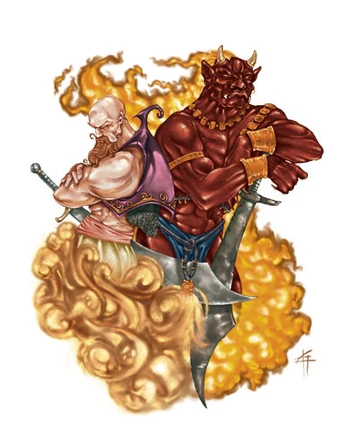 |
| 3E Genies |
And genies are highly powerful in their mastery of magic, and only gods and god-like beings can fight against the genies in equal combat. Supposedly, anyway -- in most editions, they tend to be middle-tier enemies. There's no stopping you from making a 'genie lord' or a 'noble genie' able to rewrite reality to their whim, though -- after all, Wish is the mightiest spell in Dungeons and Dragons. And while not all genies are able to do this, the mightiest of them can cast Wish, which is why the genies are targets of many mages and sorcerers who seek to subjugate them and bind them with magic. Also, while not all genies are evil, the 5E Monster Manual does characterize them as egomaniacal slavers... which is kind of odd since half of the four main genie types described afterwards lean more towards being neutral or even good.




Genies: Dao
The Dao is the genie representative from the plane of earth, and it's always consistently portrayed as neutral evil. It's also the only one out of the four 'basic' genies to not take its name from an Arabic jinn type. Originally, in the first two editions of D&D, all the genies are just depicted as, well, dudes wearing stereotypical Arabian clothing, making them look like background characters in Sinbad or something, but eventually they got different-looking appearances. The Dao's never really consistent, though, going from a noble-looking Greek dude in 3E, to an almost demonic, armoured woman in 4th Edition, to a lady with a massive hammer and a dress with the lower body that's a column of sand. I don't really think I have a preference, if we're being honest. They're genies, they can look however the fuck they want. The Dao are noted to be particularly greedy and covetous, wanting to collect as many expensive gemstones as possible, amassing slaves and creating massive palaces through the huge rock formations in the elemental plane of earth. Apparently, the Dao are easily lured thanks to their greed, and wizards are known to trap them in iron flasks and gemstones.




Genie: Djinni
Borrowing their name from the default name for these Arabic spirits, the D&D Djinni is also the one that's the most inspired from the 101 Tales of Arabian Nights genie, with most modern portrayals giving it a heavy-set body, blue skin and a beard. The djinni are also the most helpful out of the genies, ranging from chaotic good in most editions, and being unaligned at worst. They hail from the plane of air, living in huge palaces and dining on good food and whatnot. They're mischievous towards humans, and the djinni tend to not want to deal with other genies (especially the dao) due to their cruelty. They keep slaves, sure, but they treat them with kindness and will gladly part with them if there's good enough reason. Of course, just because they're nice doesn't mean they're harmless, because they can control the weather at their fingertips, riding powerful whirlwinds and manipulating massive storms. The Djinni also interestingly believe that "servitude is a matter of fate", and it is this worldview that cause them to usually just shrug off being, say, bound in a lamp and forced to grant wishes to be just bad luck, bro. Just get your wishes out of place, and don't, y'know, imprison or enslave the djinni, otherwise you'll earn the wrath of a reality-manipulating air elemental. It's honestly a pretty interesting world-view, where they're all right with temporary subjugation, but will make your life a living hell if you try to go for indefinite imprisonment.



Genie: Efreeti
The Efreeti is based on the Ifrit, a type of jinn known to be associated with death and sometimes even identified in myths as a type of Shaitan, or demon. Ifrits show up a lot in Middle-Eastern legends, but is only second to the genie as far as being more well-known to the Western world, because they show up as antagonists in multiple stories in 101 Arabian Nights, and some of the ifrit there use fire. Which is why, of course, D&D's efreeti are associated with the plane of fire! More or less consistently portrayed as hulking, shirtless musclemen with flaming scimitars, the efreeti are pretty cool-looking, and are characterized most of the time as lawful evil beings, befitting their Darth-Maul-esque visage. They're still able to transform their lower body into flames, to get that classic elemental/genie body shape, and they're cunning and ruthless, and hold a grudge against anyone who tries to force them into servitude... but, of course, their own slave-driving is totally fine. The efreeti are also characterized (particularly in 4E) as being particularly organized, living in a City of Brass and having an organized military.




Genie: Marid
Taking their name from a type of jinn or shaitan in Islamic traditions, the Marid in D&D is actually characterized as being pretty benign, being chaotic neutral. Representing the plane of water, I do find it how interesting the Marids have transformed over the multiple editions. 1E Marid shares the same generic Sinbad background extra that the dao and djinn look like, 2E Marid is kind of a stripper-y blue-skinned chick, while 3E and 4E basically takes the normal genie body shape and slapped some water onto it. And then 5E gives us a random reinvention of the Marid, turning it into this massive, opulent frog/fish-faced dude with flowing robes and a swirling tornado of water as its lower body. What? I'm not complaining, though, a weird frog-fish-faced genie is certainly far, far more distinctive than "just the djinni, but with water instead of air". Which is awesome! Personality wise, the marids honestly aren't super different from the other genies, but they are a bit more capricious, love to tell stories (often peppered with bullshit) and have a huge superiority complex, even compared to other genies. They love their titles, and apparently "the race is awash in shahs, sultans, muftis and khedives". They don't really treat humans maliciously like the dao and efreet, but they're not kind like the djinni either -- their self-inflated ego basically makes them hard to treat these humanoids in equal terms.



Ghost
 Doing these monster reviews and being a huge aficionado about general fantasy RPG monster sourcebooks and whatnot, it always struck me that one of the most repetitive monsters are ghosts. Specters. Banshees. Poltergeists. Wisps. Revenants. Shades. Phantoms. Spirits. These will always show up in every conceivable fantasy setting, because, well, ghosts in general are basically things that are common in every culture. The fear of death is omni-present among humanity, and even scarier than that is the supernatural, that somehow, there are these twisted spirits from beyond the grave that's able to cheat even death, staying trapped in the material realm for some reason or another. D&D being D&D, we're going to see a bunch of these otherworldly beings down the road (and in fact, we've covered the Banshee), but the D&D ghost keeps things very basic. It's a transparent, floating humanoid that is the soul of a once-living being, it can float, it can pass through walls, it causes some supernatural happenings around it, it scares people... and perhaps most annoying, it can possess people. Without getting into gaming jargon... possession is very much annoying and could honestly really fuck up your party.
Doing these monster reviews and being a huge aficionado about general fantasy RPG monster sourcebooks and whatnot, it always struck me that one of the most repetitive monsters are ghosts. Specters. Banshees. Poltergeists. Wisps. Revenants. Shades. Phantoms. Spirits. These will always show up in every conceivable fantasy setting, because, well, ghosts in general are basically things that are common in every culture. The fear of death is omni-present among humanity, and even scarier than that is the supernatural, that somehow, there are these twisted spirits from beyond the grave that's able to cheat even death, staying trapped in the material realm for some reason or another. D&D being D&D, we're going to see a bunch of these otherworldly beings down the road (and in fact, we've covered the Banshee), but the D&D ghost keeps things very basic. It's a transparent, floating humanoid that is the soul of a once-living being, it can float, it can pass through walls, it causes some supernatural happenings around it, it scares people... and perhaps most annoying, it can possess people. Without getting into gaming jargon... possession is very much annoying and could honestly really fuck up your party.Ghosts in D&D have been relatively consistently portrayed as spirits that are bound to either a location, person or object, trying to complete some unfinished business, playing off a lot of common tropes with ghostly stories. And so that your DM can have a variety of ghosts to pick from, the Monster Manual suggests that ghosts are very variable thanks to the circumstances that created them (and to homage a lot of depictions of ghosts in the mainstream media). Some are unaware that they died and go about their daily routines, repeating them over and over. Some are trying actively to avenge their death, or seek aid from the living. Some are just straight-up evil. There's a neat bit of roleplaying uniqueness becasue the ghosts have a special weakness if you can figure out how they died in the first place, which I don't think is a trope that's commonly applied to ghosts? And, of course, there's the whole "please help resolve my unfinished business" deal that could apply to either antagonistic or helpful ghosts. I've always disliked the fact that ghosts and specters tend to basically just end up as "hey, beat up these guys with magic weapons and make them even deader", which really makes them feel mundane for what would've otherwise be a terrifying, spiritual threat. I always appreciate DM's that are able to integrate the ghosts and ghost-like undead in a way where fighting them involves something more. The 5E Manual does give us a bunch of hooks, and I appreciate that.
Overall, again, a pretty basic collection of common ghost tropes, pretty fitting for what's basically the 'basic' ghost of the setting. Which, depending on how you set it up, could either be a particularly annoying encouter, an NPC beseeching you for help, or just a bunch of 'seasoning' minions controlled by a vampire lord or something.



Ghoul
"Ghoul" is one of those monsters that have such a wildly different interpretation depending on the media. Click here for Wikipedia's list of ghoul depictions in popular culture, and to quote TVTropes, our ghouls are different. The original Arabic myths of ghouls are basically just hideous human-like monsters (or monstrous men?) that lures travelers astray, and somewhere along the line, the legend of the ghoul was codified in Arabian Nights as a cannibal that feasts upon corpses. The D&D ghoul basically runs with an adaptation of this, making ghouls into a type of gangly, monstrous undead that lurk in crypts and catacombs with a hunger for flesh. Specifically, dead flesh. And your bunch of foolish adventurers that wander into their territory? Well, if they're not dead yet, the ghouls are more than willing to make you dead. And they're basically the 'rabid dog' compared to the skeletons and zombies being more clueless. They're mindless, but are driven so much by primal hunger that it makes them a bit more of a problem to fight compared to others. Unlike zombies, their flesh doesn't rot, and they just stay in this perpetual state of, well, I guess 'true' undeath? In D&D lore, ghouls are specifically tied to the demon lord Orcus (the one who's all about the undead), and, uniquely, elves are immune to many of the debilitating effects that ghouls are able to unleash.
Ghast
 Being an RPG, of course most 'base' monsters have a more powerful version of themselves. But ghouls are one of the few whose stronger version isn't something with an adjective slapped onto it, but rather a creature with its own unique name, the ghast. We don't really learn much about ghasts, though, despite being around since forever. Their origins vary -- in some editions, they are simply ghouls that are more powerful because they were made from the corpses of stronger warriors; or, in 5E, are directly created by Orcus through infernal intervention. The ghasts are basically far stronger than ghouls, able to command the others, and one feature that the ghasts consistently have throughout their numerous appearances is their foul, foul stench. Ghastly!
Being an RPG, of course most 'base' monsters have a more powerful version of themselves. But ghouls are one of the few whose stronger version isn't something with an adjective slapped onto it, but rather a creature with its own unique name, the ghast. We don't really learn much about ghasts, though, despite being around since forever. Their origins vary -- in some editions, they are simply ghouls that are more powerful because they were made from the corpses of stronger warriors; or, in 5E, are directly created by Orcus through infernal intervention. The ghasts are basically far stronger than ghouls, able to command the others, and one feature that the ghasts consistently have throughout their numerous appearances is their foul, foul stench. Ghastly!Giants
Another group of creatures that's almost sure to get a whole load of sub-types are the giants. And, again, it's easy to see why. Many mythologies tend to feature giants as antagonists and villains, and many different mythologies also tend to feature different kinds of giants.... and there's just something that is especially satisfying and primal about fighting a creature that's essentially you, but magnified multiple times in size, y'know? Like dragons and demons and devils, older editions tend to have expanded bestiaries about other types of giants and whatnot, but the 5th Edition Monster Manual basically just has the six of the original giants featured in 1E AD&D's Monster Manual: Cloud, Storm, Hill, Stone, Frost and Fire, and generally, they stylistically draw a lot from a mish-mash of Grecian and Nordic myths.
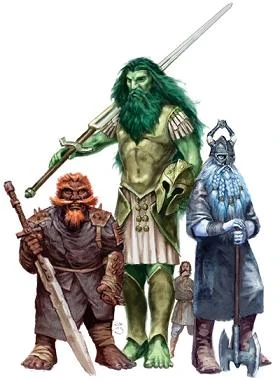 |
| 3E Giants |
I've never really found these guys to be particularly as 'cool' as monster designs, although the couple of times that my D&D group faced against giants, they tend to be insanely harrowing encounters. Their lore is also pretty neat. Giants honestly tend to run the gamut of allegiances, and aren't 'locked' into a single category like most other races, with any giant you meet potentially being an evil, xenophobic, spiteful warrior, or just a gentle dude living in a remote ruin who might just be a wee bit ignorant about the customs of us tiny folk.



Storm Giant
 Playing off real-life mythology, some of the mightiest 'leader' gods have mastery over the skies and storms, because our ancestors viewed these thunderstorms as something so immensely impossible that truly only the mightiest of gods like great Zeus or mighty Thor can hurl thunderbolts and summon massive hurricanes. Storm Giants, thusly, are the mightiest of the giants, and nearly all of their artwork make their mythology-inspired origins pretty damn clear. The Storm Giants, of course, control storms, and they're actually chaotic good, in stark difference to the other giants. They don't really keep their brethren in line, though, living as reclusive hermits as prophet-kings, either below the sea or above the surface of the world in mountains or the cloud-cities of their cloud giant kin. Despite being mighty beings that could affect entire continents with their fury, storm giants (at least in 5E) are characterized as mostly playing a long game, trying to divine Annam's will in cosmic signs and acting more as prophets and seers than actual active participants in the world, because, well, they've watched the same song and dance so many times among the mortals, so why bother intervening? So much of storm giant culture basically revolves around them interpreting signs.
Playing off real-life mythology, some of the mightiest 'leader' gods have mastery over the skies and storms, because our ancestors viewed these thunderstorms as something so immensely impossible that truly only the mightiest of gods like great Zeus or mighty Thor can hurl thunderbolts and summon massive hurricanes. Storm Giants, thusly, are the mightiest of the giants, and nearly all of their artwork make their mythology-inspired origins pretty damn clear. The Storm Giants, of course, control storms, and they're actually chaotic good, in stark difference to the other giants. They don't really keep their brethren in line, though, living as reclusive hermits as prophet-kings, either below the sea or above the surface of the world in mountains or the cloud-cities of their cloud giant kin. Despite being mighty beings that could affect entire continents with their fury, storm giants (at least in 5E) are characterized as mostly playing a long game, trying to divine Annam's will in cosmic signs and acting more as prophets and seers than actual active participants in the world, because, well, they've watched the same song and dance so many times among the mortals, so why bother intervening? So much of storm giant culture basically revolves around them interpreting signs.Also, Storm Giants can also live anywhere -- including underwater. Which means, that, yeah, sometimes these are the ultimate embodiment of sea storms and the like that you meet in the ocean, like some mighty figure out of Greek myth.



Cloud Giant
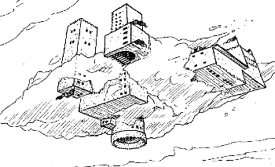 |
| Cloud castle |
The 5E Manual also basically pinpoints the cloud giants as being at least partially influenced by Jack and the Beanstalk, because cloud giants are apparently extraordinary gardeners, and the massive crops from their fields 'lead to tales of magic beans'. The kinder ones among them might be predisposed towards sharing this with the humanoids that it views to be its 'charges'. The way the cloud giant clans decide which ones are higher in social standing basically depends on their wealth, and how they display their wealth. They're not just hoarders, they're connoisseurs. They're basically a race full of those rich, pompous dudes living in private mansions bragging about their latest custom private jet or custom-built villa or whatever. And also, apparently they entertain themselves by betting on events, so... yeah, exactly like decadent rich folk. Honestly, I've never really thought much about these cloud giants until re-reading their entry for the Monster Manual. I'm a fan!



Fire Giant
I'm actually impressed with the amount of words that the 5th Edition Monster Manual devotes to the giants, giving them as much, if not more, write-ups in comparison to dragons or fiends. I still don't find them super interesting, although I do really like how 5th Edition gave us a big top-heavy Ganondorf as the fire giant. Significantly lower on the giants' social rung, the fire giants are basically what you expect from a 'fire giant'. They live in volcanoes and fortresses, they have fire powers, they are great smiths, and their entire culture tends to revolve around war and combat. I do like the description that the fire giants are also shrewd tacticians, and many people underestimate them for being angry rage-beasts. And they are that, too, certainly, but they're not dumb. They're not the most interesting thing in the Monster Manual, honestly, but they do have cool artwork and a pretty neat description of their society. These newer Sourcebooks, thanks to page economy, tend to really skimp on trying to describe the civilization of the more intelligent races, and we get some surprisingly neat, verbose ones for the various giants!



Frost Giant
Obviously drawing inspiration from the Jotunn of Norse legend, the frost giant basically looks exactly what you'd expect from the pages of any book detailing Thor -- be it Marvel comics or more mythologically-accurate retellings of the myths. Muscular, blue skin, massive beards, Viking helmets... yep! Lower than the fire giant on the giant totem pole, the frost giants are what you expect from a race of Viking giants. They are warriors and raiders, they live in the snow, and I do love the description of the villages that are left in the wake of frost giant raids -- not finding any use in gold or money, they destroy things like farms, storehouses and smithies, in particular. They're giant ice-breathing vikings! Not much to go on here. Both fire and frost giants are considered always evil, so yeah, these guys, as well as the hill giants, are common adversaries depending on the setting of your campaign.



Stone Giant
I really don't have much to go on about the neutral-aligned stone giants. They're lankier, have skin made out of stone, and they live in caves as reclusive, peaceful hermits. And they love their little pet bears, apparently, something that the 5E Monster Manual threw in presumably as a reference to its original 1E artwork. Where the fire giants forge weapons of war, the stone giants are more peaceful and are stonecarvers and artisans, believing that carving shapes out of stone honour their god... and even in battle, they seek to basically utilize art. Sure, they are throwing stones at the humanoids attacking their lair, but they are doing artistic lobs, y'know? Just imagine these stern, stone-faced dudes striking an epic JoJo pose as they artfully twirl and toss rocks to turn a human into a blood paste. Interestingly, the stone giants have such an odd view of the world that they view the world outside their underground homeas as basically dreams where nothing is entirely true, and that's why they sometimes behave erratically and destructively, because, well, it's a dream, so why bother? Honestly, it's a very interesting little detail that makes me really appreciate these guys a lot more.



Hill Giant
The lowest of the true giants, the hill giant... is just a huge hungry dude! Depending on the edition, he's just some dude, a very muscular dude, or a pot-bellied dad. Honestly, the only thing that really separates it from something like an ogre is its size and strength, and the fact that in 5E they're super-duper hungry. The Monster Manual just basically goes on and on in describing these dudes as brutish giant thugs that only live and survived this long because of their massive physical strength, and don't even realize that there's a system like the ordning, only obeying the other giants because they have powers that they don't and are clearly stronger. Adorably, the Monster Manual also note that the hill giants are so dumb that they could be fooled by "a group of villagers hiding under a blanket and standing on top of one another, holding a giant pumpkin head".



Gibbering Mouther
How GLORIOUS is this thing? The Gibbering Mouther is easily one of my favourite monsters the first time I cracked open one of these Monster Manuals. They showed up in the 1st Edition Monster Manual and has consistently shown up in every other Monster Manual since, rightfully being one of the 'classic' D&D monsters that's held as one of its signature monsters. And what's there not to love about these things? Giant formless flesh-blobs of tentacles that's filled with eyes and mouths of different shapes and sizes, the Gibbering Mouther looks Lovecraftian yet hilarious at the same time. There's the inherent horror of something so bizarrely monstrous and indescribable, but even the more serious modern artwork do find a lot of fun in the sheer inherent goofiness of a bunch of eyes and mouths on a blob of goop.
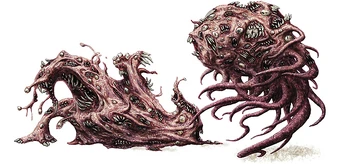 |
| 4E Gibbering Mouther & Orb |



Githyanki
 Y'know... I've never really cared all that much about the Gith, and I'm not quite sure why. Introduced in the Monster Manual II of the first edition of D&D, the Gith are a race that once lived on a different plane, who fought and liberated themselves against their Mind Flayer slavers, and became two unique cultures -- the war-like Githyanki and the contemplative Githzerai. I'm not quite sure why I never really took to the Gith despite not minding many of D&D's other original humanoid societies. Maybe it's just because I've never really met them in a campaign? They're like these noseless, yellow-skinned quasi-elves with fancy hairdos, often with psionic powers, and the base concept of their race's split into two is pretty interesting -- after the heroine Gith freed the race from their Illithid masters, the race ended up breaking apart in infighting, from Gith's supporters, to others who supported another leader, Zerthimon, who condemned Gith's martial law as another form of slavery.
Y'know... I've never really cared all that much about the Gith, and I'm not quite sure why. Introduced in the Monster Manual II of the first edition of D&D, the Gith are a race that once lived on a different plane, who fought and liberated themselves against their Mind Flayer slavers, and became two unique cultures -- the war-like Githyanki and the contemplative Githzerai. I'm not quite sure why I never really took to the Gith despite not minding many of D&D's other original humanoid societies. Maybe it's just because I've never really met them in a campaign? They're like these noseless, yellow-skinned quasi-elves with fancy hairdos, often with psionic powers, and the base concept of their race's split into two is pretty interesting -- after the heroine Gith freed the race from their Illithid masters, the race ended up breaking apart in infighting, from Gith's supporters, to others who supported another leader, Zerthimon, who condemned Gith's martial law as another form of slavery.The Githyanki are those that follow Gith's more savage teachings, being identified as lawful evil. They are also some kind of space raiders, going through planes and astral vessels and riding red dragons as they plunder other worlds. They're particular dicks that leave just enough of the worlds they plunder to rebuild... so they can go back and raid it again and again. What dicks! They serve Gith's successor, the lich queen Vlaakith, and the Githyanki are held in a rigid caste system and are super-duper xenophobic. They also basically embody the psionic powers in D&D settings, and their combat culture revolves around the ability to summon and wield a psychic silver blade -- and these silver blades are a very, very important part of their culture. Also, thanks to an ancient deal that Gith struck with Tiamat, the Githyanki society has their own massive brood of red dragons that they ride as mounts.



Githzerai
Githzerai, meanwhile, are lawful neutral, and are philosophers and benevolent thinkers, pursuing lives of order. They're also untrusting of outsiders, although not to the extent of their Githyanki cousins. They basically hang out the plane of Limbo as nomads, content to live their life in peace. In combat, they basically go for a mind-over-matter philosophy, tending to use their psychic powers to disable opponents. They're an entire race of mostly-benign psychic monks, a whole race of Yodas, I guess? Both Githyanki and Githzerai really hate each other, but their worst enemies are the mind flayers. Githyankis slay mind flayers as a rite of passage, and only warriors that have bloodied their blades with illithid blood are allowed to rejoin their people, whereas the Githzerai tend to organize large raids to crack down on illithid societies.
And... yeah, I'm genuinely not sure why I am just so indifferent about the Gith. They're honestly pretty dang cool, I like the world-building aspect behind them, and I certainly don't hate them, but I am hard-pressed to really talk a lot about them or gush over them the way I do other races. I guess the weird planar-hopping thing just felt kinda off in a D&D setting? And it really shouldn't be, since so many other monsters and aspects of D&D also feature jumping from one realm to the next, but I dunno. Just not a big fan, I guess.



Gnoll
 I was somewhat more lukewarm about the massive chunk of giants and gith that came before this, so it's neat that I'm going to end this article with one of my all-time favourite classic monsters, the Gnolls. And the gnoll really isn't the most original race concept ever, very loosely taking inspiration from the half-gnome, half-troll gnole of the Book of Eonder. D&D's Gnolls, and the various fantasy settings that copy the gnolls, are savage hyena-men, who are brutal monsters that raid villages, and also are just challenging enough for lower-level players without being too threatening. And I'm not sure what is it about hyenas that got them typecast as villains all the time, but it kinda works? A hyena's mutt-like appearance and general gangliness does instantly translate to a pretty threatening, nasty-looking silhouette. And that's before you work in the colouration, the sinister cackling, and the over-exaggerated evil reputation as scavengers. The gnolls are honestly pretty fun! They're stronger than things like kobolds and goblins, and each gnoll is individually enough of a threat. It's like fighting a dire wolf or a hyena, but they're on their legs, able to wield weapons, and able to reason. And that's without going to the gnolls that can actually do more than just generic mauling! 5E has the Gnoll Pack Lord as the buffed-up member of the tribe, and there's the Gnoll Fang of Yeenoghu, who is blessed by their patron demon-god, Yeenoghu, who allows a particularly victorious and savage gnoll to be possessed by one of his demonic spirits, transforming them into more savage, demonic forms that are actually considered fiends by the game, and is able to transform hyenas into gnolls.
I was somewhat more lukewarm about the massive chunk of giants and gith that came before this, so it's neat that I'm going to end this article with one of my all-time favourite classic monsters, the Gnolls. And the gnoll really isn't the most original race concept ever, very loosely taking inspiration from the half-gnome, half-troll gnole of the Book of Eonder. D&D's Gnolls, and the various fantasy settings that copy the gnolls, are savage hyena-men, who are brutal monsters that raid villages, and also are just challenging enough for lower-level players without being too threatening. And I'm not sure what is it about hyenas that got them typecast as villains all the time, but it kinda works? A hyena's mutt-like appearance and general gangliness does instantly translate to a pretty threatening, nasty-looking silhouette. And that's before you work in the colouration, the sinister cackling, and the over-exaggerated evil reputation as scavengers. The gnolls are honestly pretty fun! They're stronger than things like kobolds and goblins, and each gnoll is individually enough of a threat. It's like fighting a dire wolf or a hyena, but they're on their legs, able to wield weapons, and able to reason. And that's without going to the gnolls that can actually do more than just generic mauling! 5E has the Gnoll Pack Lord as the buffed-up member of the tribe, and there's the Gnoll Fang of Yeenoghu, who is blessed by their patron demon-god, Yeenoghu, who allows a particularly victorious and savage gnoll to be possessed by one of his demonic spirits, transforming them into more savage, demonic forms that are actually considered fiends by the game, and is able to transform hyenas into gnolls. In D&D lore, the gnolls trace their origin to the demon lord Yeenoghu, who's as vile and brutal as his hyena-men children. The gnolls themselves are basically nomadic tribes that plunder villages at random, pillaging and killing random small settlements and targeting smaller villages that tend to not have any sort of protection. While they don't scavenge for dead flesh (they work for their food!) they do scavenge the weapons and clothes of their victims, so that's neat! Gnolls have been kind of one of the more popular races to come out of D&D, and I love them, too -- the gnolls have often been one of the first races to receive the 'monstrous PC race' treatment... which I'm not sure works, and in 5E in particular, canon!gnolls are bloodthirsty and are driven by an innate sense of slaughter and mayhem. But hey, if the drow can have their Drizzt Do'urden, there's no stopping you from making a noble gnoll rebelling from his or her society, and casting off Yeenoghu's grip on their clan, Warcraft-orcs style! Again, the Monster Manual doesn't really characterize them all that much beyond highlighting their barbaric tendencies, but the gnolls do get a lot of love from D&D. For 5E in particular, the gnoll is one of the races to be featured and expanded upon in Volo's Guide to Monsters, describing just how fanatical they are to the art of senseless slaughter and murder, describing multiple variants of super-gnolls touched by Yeenoghu, and noting their superstitious tendencies of seeing signs in everything.
In D&D lore, the gnolls trace their origin to the demon lord Yeenoghu, who's as vile and brutal as his hyena-men children. The gnolls themselves are basically nomadic tribes that plunder villages at random, pillaging and killing random small settlements and targeting smaller villages that tend to not have any sort of protection. While they don't scavenge for dead flesh (they work for their food!) they do scavenge the weapons and clothes of their victims, so that's neat! Gnolls have been kind of one of the more popular races to come out of D&D, and I love them, too -- the gnolls have often been one of the first races to receive the 'monstrous PC race' treatment... which I'm not sure works, and in 5E in particular, canon!gnolls are bloodthirsty and are driven by an innate sense of slaughter and mayhem. But hey, if the drow can have their Drizzt Do'urden, there's no stopping you from making a noble gnoll rebelling from his or her society, and casting off Yeenoghu's grip on their clan, Warcraft-orcs style! Again, the Monster Manual doesn't really characterize them all that much beyond highlighting their barbaric tendencies, but the gnolls do get a lot of love from D&D. For 5E in particular, the gnoll is one of the races to be featured and expanded upon in Volo's Guide to Monsters, describing just how fanatical they are to the art of senseless slaughter and murder, describing multiple variants of super-gnolls touched by Yeenoghu, and noting their superstitious tendencies of seeing signs in everything.5E stats in the Monster Manual for the creatures we covered here:
- Fomorian: Huge giant; chaotic evil; CR 8
- Gas Spore: Large plant; unaligned; CR 1/2
- Shrieker: Medium plant; unaligned; CR 0
- Violet Fungus: Medium plant; unaligned; CR 1/4
- Galeb Duhr: Medium elemental; neutral; CR 6
- Gargoyle: Medium elemental; chaotic evil; CR 2
- Dao: Large elemental; neutral evil; CR 11
- Djinni: Large elemental; chaotic good; CR 11
- Efreeti: Large elemental; lawful evil; CR 11
- Marid: Large elemental: chaotic neutral; CR 11
- Ghost: Medium undead; any alignment; CR 4
- Ghoul: Medium undead; chaotic evil; CR 1
- Ghast: Medium undead; chaotic evil; CR 2
- Cloud Giant: Huge giant; neutral good 50% / neutral evil 50%; CR 9
- Fire Giant: Huge giant; lawful evil; CR 9
- Frost Giant: Huge giant; neutral evil; CR 8
- Hill Giant: Huge giant; chaotic evil; CR 5
- Stone Giant: Huge giant; neutral; CR 7
- Storm Giant: Huge giant; chaotic good; CR 13
- Gibbering Mouther: Medium aberration; neutral; CR 2
- Githyanki Warrior: Medium humanoid - gith; lawful evil; CR 3
- Githyanki Knight: Medium humanoid - gith; lawful evil; CR 8
- Githzerai Monk: Medium humanoid - gith; lawful neutral; CR 2
- Githzerai Zerth: Medium humanoid - gith; lawful neutral; CR 6
- Gnoll: Medium humanoid - gnoll; chaotic evil; CR 1/2
- Gnoll Pack Lord: Medium humanoid - gnoll; chaotic evil; CR 2
- Gnoll Fang of Yeenoghu: Medium fiend - gnoll; chaotic evil; CR 4
That's the article Reviewing D&D Monsters - 5E Monster Manual, Fomorians to Gnolls
That's it for the article Reviewing D&D Monsters - 5E Monster Manual, Fomorians to Gnolls this time, hopefully can be useful for all of you. okay, see you in another article post.
You are now reading the article Reviewing D&D Monsters - 5E Monster Manual, Fomorians to Gnolls with link address https://kanakoroku.blogspot.com/2019/10/reviewing-d-monsters-5e-monster-manual.html
